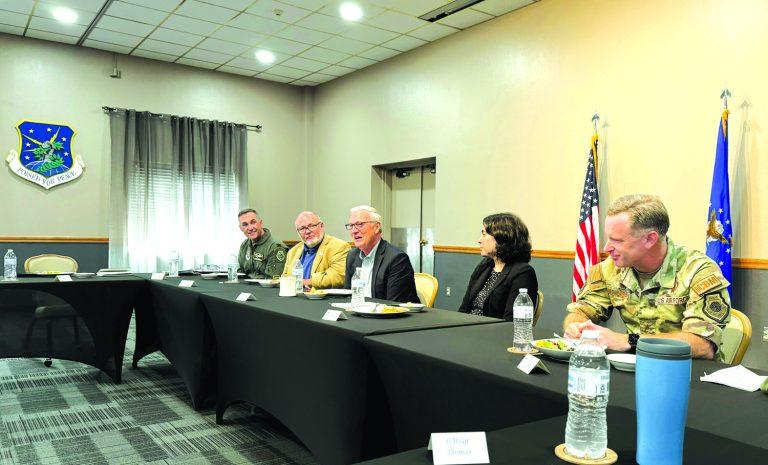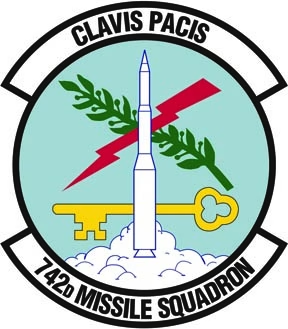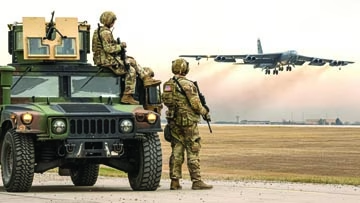MINOT, N.D. – Under Secretary of the U.S. Air Force Melissa Dalton visited Minot Air Force Base (AFB) this week to see firsthand the capabilities of the bomber and missile enterprise and meet with airmen, Minot Group Command Teams, and Task Force 21 Civic Leaders. U.S. Senator Kevin Cramer (R-ND) invited Dalton to North Dakota during her confirmation hearing.
Minot AFB is home to two major Air Force units and is the only base to house two out of three legs of the nuclear triad, the 5th Bomb Wing and the 91st Missile Wing. The 5th Bomb Wing operates the B-52H Stratofortress aircraft, which provides global strike and combat-support capabilities to geographic commanders. The 91st Missile Wing operates and maintains the Minuteman III missiles, which defend the nation with a combat-ready nuclear force. The Air Force’s Sentinel program is modernizing the Ground Based Strategic Deterrent (GBSD), replacing the Minuteman missiles stationed at Minot, Malmstrom, and F.E. Warren Air Force bases. During the visit, Cramer and Dalton discussed the strategic importance of Minot AFB and the critical nature of the modernization efforts.
“The number one priority of our national defense strategy is nuclear modernization, and Minot Air Force Base is at the heart of this effort with two of the three legs of our triad,” said Cramer. “As one of its most vital programs, it is imperative the Air Force never reduces the geographical redundancy of Sentinel’s placement. No hearing or briefing in Washington can replace seeing a B-52 or Minuteman missile in person, not to mention the dedicated airmen who operate and maintain these awesome capabilities. It’s true that only the best come North. I appreciate Under Secretary Dalton following through on her commitment to visit North Dakota and see the central role Minot plays in our national defense.”
As a member of the Senate Armed Services Committee (SASC), Cramer is a strong supporter of the nation’s nuclear triad and has pushed military leadership to keep GBSD modernization funded and on time. In January, the Sentinel program triggered a Nunn-McCurdy breach, meaning the project costs increased more than 25% over original estimates. When this occurs, the program must be canceled unless the U.S. Department of Defense (DOD) certifies to Congress the program meets established criteria to continue. In July, DOD declared the “Sentinel program remains essential to U.S. national security and is the best option to meet the needs of our warfighters” and the Air Force is restructuring the project to address budgetary and management shortcomings.
Cramer used his seat on SASC to secure key provisions in the Fiscal Year 2024 National Defense Authorization Act. This includes $3.7 billion for Sentinel GBSD modernization to replace the 70-year-old Minuteman III missile and $770 million for the B-52 commercial engine replacement program and radar modernization. Further, it provides $228 million for MH-139A Gray Wolf helicopters to replace the aging UH-1 helicopters at Minot AFB, and $40.8 million for the Nuclear Command, Control & Communication (NC3) program.
This visit to Minot caps the end of Cramer’s August visits to military installations and defense ecosystem partners in North Dakota. Earlier in the month, Cramer flipped the switch to bring the Space Development Agency (SDA) Operations Center North online at Grand Forks Air Force Base (GFAFB), participated in a Grand Forks Base Retention Committee meeting, toured the University of North Dakota (UND) National Security Corridor, and announced new Navy personnel at GFAFB. Cramer also joined E-Space CEO Greg Wyler in meeting with UND faculty and SDA staff to discuss workforce development and initiatives, announced educational initiatives between SDA and UND, and toured Collins Aerospace in Jamestown.












